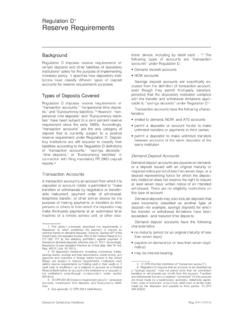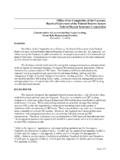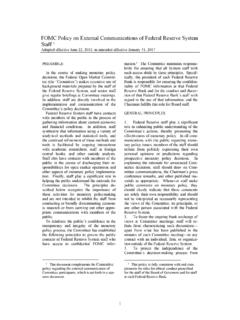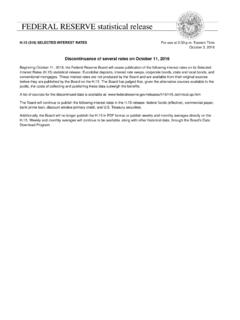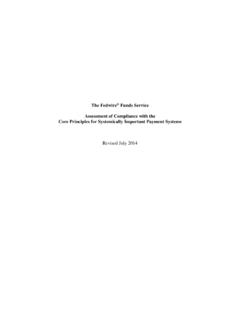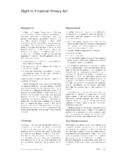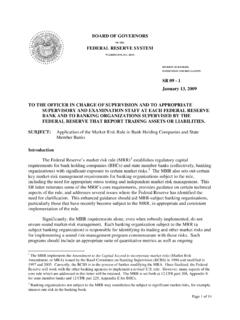Transcription of Regulation H Flood Disaster Protection
1 Regulation HFloodDisaster ProtectionIntroductionTheNational Flood insurance Program (NFIP) isadministered primarily under the national FloodInsurance Act of 1968 (1968 Act) and the FloodDisaster Protection Act of 1973 (FDPA).1 The 1968 Act made federally subsidized Flood insuranceavailable to owners of improved real estate ormobile homes located in special Flood hazard areas(SFHA) if their community participates in the NFIP, administered by a department of theFederal Emergency management Agency (FEMA)known as the Federal insurance and MitigationAdministration (FIMA), makes federally backedflood insurance available to consumers throughNFIP Direct Program agents who deal directly withFEMA or through the Write Your Own (WYO)
2 Program, which allows consumers to purchasefederal Flood insurance from private insurancecarriers. The NFIP aims to reduce the impact offlooding by providing affordable insurance toproperty owners and by encouraging communitiesto adopt and enforce floodplain managementregulations. The FDPA requires federal financialregulatory agencies to adopt regulations prohibit-ing their regulated lending institutions from making,increasing, extending, or renewing a loan securedby improved real estate or a mobile home locatedor to be located in an SFHA in a communityparticipating in the NFIP unless the propertysecuring the loan is covered by Flood insurance may be provided through the NFIPor through a private insurance V of the Riegle Community Developmentand Regulatory Improvement Act of 1994.
3 2which iscalled the national Flood insurance Reform Act of1994 (1994 Act), comprehensively revised thefederal Flood insurance statutes. The purpose of the1994 Act was to increase compliance with floodinsurance requirements and participation in theNFIP in order to provide additional income to theNational Flood insurance Fund and to decrease thefinancial burden of flooding on the federal govern-ment, taxpayers, and Flood 1994 Actrequired the federal financial regulatory agencies,the Board of Governors of the Federal ReserveSystem (FRB); the Federal Deposit InsuranceCorporation (FDIC); the national Credit UnionAdministration (NCUA).
4 And the Office of theComptroller of the Currency (OCC) to revise theircurrent Flood insurance regulations and broughtlenders regulated by the Farm Credit Administra-tion (FCA) under the coverage of the federal floodinsurance statutes. The federal financial regulatoryagencies and the FCA (collectively, the Agencies)jointly issued regulations on August 29, 1996 (61FR 45684).4 The 1994 Act also made the Flood insurancerequirements directly applicable to the loans pur-chased by the Federal national Mortgage Associa-tion (Fannie Mae) and the Federal Home LoanMortgage Corporation (Freddie Mac) and to agen-cies that provide government insurance or guaran-tees such as the Small Business Administration(SBA), Federal Housing Administration (FHA), andthe Department of Veterans Affairs (VA).
5 The mandatory Flood insurance purchase require-ments of the FDPA were again significantlyamended with the passage of the Biggert-WatersFlood insurance Reform Act of 2012 (Biggert-Waters Act) and the Homeowner Flood InsuranceAffordability Act of 2014 (HFIAA). These statutesmade changes to the provisions pertaining to forceplacement of Flood insurance ; escrowing of floodinsurance premiums and fees; exemptions to themandatory Flood insurance purchase requirement;and civil money penalties. Moreover, a new provi-sion mandating the acceptance of a private floodinsurance policy meeting certain criteria as satis-faction of the mandatory purchase requirement wasadded to the FDPA.
6 The Agencies jointly issuedrules addressing force placement, escrow, and theexemption to the mandatory purchase requirementfor detached structures on July 21, 2015 (80 FR43215).Objectives of the FDPA Provide Flood insurance to owners of improvedreal estate located in SFHAs of communitiesparticipating in the NFIP. Require communities to enact measures de-signed to reduce or avoid future Flood losses asa condition for making federally subsidized floodinsurance available. Require federal financial regulatory agencies toadopt regulations prohibiting their regulatedlending institutions from making, increasing,1.
7 These statutes are codified at 42 USC 4001-4129. FEMA administersthe NFIP; its regulations implementing the NFIP appear at 44 CFR parts Pub. , Title V, 108 Stat. 2160, 2255-87 (Septem-ber 23, 1994).3. Conf. Rep. No. 652, 103d Cong. 2d Sess. 195 (1994).(Conference Report).4. Agency regulations are codified at 12 CFR 22 (OCC);12 CFR 208 (FRB); 12 CFR 339 (FDIC); 12 CFR 614 (FCA); 12 CFR760 (NCUA).Consumer Compliance HandbookReg. H Flood Protection 1 (7/16)extending, or renewing a loan secured byimprovedreal estate or a mobile home located orto be located in an SFHA of a communityparticipating in the NFIP, unless the propertysecuring the loan is covered by Flood insurance .
8 Require federal agencies, such as the FHA, theSBA, and the VA not to subsidize, insure, orguarantee any loan if the property securing theloan is in an SFHA of a community not participat-ing in the Eligible for Flood Insuranceunder the NFIPThe NFIP covers improved real property or mobilehomes located or to be located in an area identifiedby FEMA as having special Flood hazards. Gener-ally, each insurable structure requires a separateinsurance policy. The following types of structuresare eligible for coverage: residential, industrial, commercial, and agricul-tural buildings that are walled and roofedstructures that are principally above ground buildings under construction where a develop-ment loan is made to construct insurable improve-ments on the land.
9 insurance can be purchasedto keep pace with the new construction mobile homes that are affixed to a permanentsite, including mobile homes that are part of adealer s inventory and affixed to permanentfoundations condominiums co-operative buildings Flood insurance coverage is also available forpersonal property and other insurable contentscontained in real property or mobile homeslocated in SFHAs. The property must be insuredin order for the contents to be Not Eligible for FloodInsurance under the NFIP unimproved land, bridges, dams, and roads mobile homes not affixed to a permanent site travel trailers and campers converted buses or vans buildings entirely in, on, or over water into whichboats are floated buildings newly constructed or substantiallyimproved on or after October 1, 1983.
10 In an areadesignated as an undeveloped coastal barrierwith the Coastal Barrier Resource System estab-lished by the Coastal Barrier Resources Act(Public Law 97-348) Flood insurance requirements forLending InstitutionsBasic RequirementFlood insurance , either issued through the NFIP orfrom a private insurance provider, is required forthe term of the loan on buildings or mobile homeswhen an institution makes, increases, extends, orrenews a designated loan, meaning all three of thefollowing factors are present: the loan (commercial or consumer) is secured byimproved real estate or a mobile home that isaffixed to a permanent foundation (securityproperty); the property securing the loan is located or willbe located in an SFHA as identified by FEMA.
